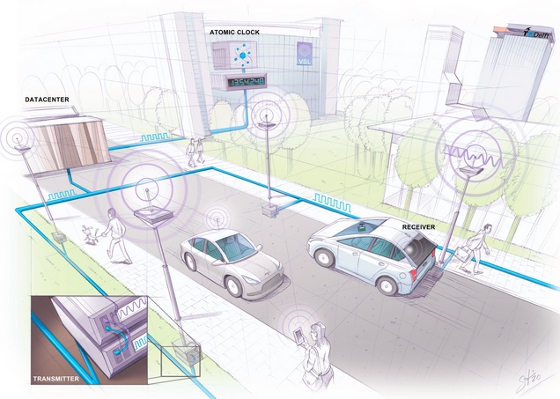 |
| November 29, 2022 | Volume 18 Issue 44 |
Designfax weekly eMagazine
Archives
Partners
Manufacturing Center
Product Spotlight
Modern Applications News
Metalworking Ideas For
Today's Job Shops
Tooling and Production
Strategies for large
metalworking plants
'SuperGPS' aims for 10-cm accuracy in urban settings
Researchers in the Netherlands have developed an alternative positioning system that is more robust and accurate than current satellite GPS, especially in urban settings. Their working prototype for the new mobile network infrastructure demonstrated an accuracy of 10 cm. This new technology could prove to be important for the implementation of a range of location-based applications, including automated vehicles, quantum communication, and next-generation mobile communication systems. The results were published in Nature Nov. 16, 2022.
A lot of our vital infrastructure relies on global navigation satellite systems such as the U.S. GPS and EU Galileo. These systems that rely on satellites have their limitations and vulnerabilities. Their radio signals can be weak when received on Earth, and accurate positioning is no longer possible if the radio signals are reflected or blocked by buildings.
"This can make GPS unreliable in urban settings, for instance," says Christiaan Tiberius of Delft University of Technology and coordinator of the project, "which is a problem if we ever want to use automated vehicles. Also, citizens and our authorities actually depend on GPS for many location-based applications and navigation devices. Furthermore, so far we have no back-up system."
The aim of the "SuperGPS" project taken on by researchers at Delft University of Technology, Vrije Universiteit Amsterdam, and VSL National Metrology Institute was to develop an alternative positioning system that makes use of the mobile telecommunication network instead of satellites and could be more robust and accurate than GPS.

Illustration of the hybrid optical-wireless network that demonstrated 10-cm-level positioning in urban environments. [Credit: TU Delft/Stephan Timmers]
"We realized that with a few cutting-edge innovations, the telecommunication network could be transformed into a very accurate alternative positioning system that is independent of GPS," says Jeroen Koelemeij of Vrije Universiteit Amsterdam. "We have succeeded and have developed a system that can provide connectivity just like existing mobile and Wi-Fi networks do, as well as accurate positioning and time distribution like GPS."
An atomic clock on the ground is key
One of the key innovations is to connect the mobile network to a very accurate atomic clock, so that it can broadcast perfectly timed messages for positioning, just like GPS satellites do with the help of the atomic clocks they carry on board. These connections are made through the existing fiber-optic network.
"We had already been investigating techniques to distribute the national time produced by our atomic clocks to users elsewhere through the telecommunication network," says Erik Dierikx of VSL. "With these techniques, we can turn the network into a nationwide distributed atomic clock -- with many new applications such as very accurate positioning through mobile networks. With the hybrid optical-wireless system that we have demonstrated now, in principle anyone can have wireless access to the national time produced at VSL. It basically forms an extremely accurate radio clock that is good to one-billionth of a second."
The system also employs radio signals with a bandwidth much larger than is commonly used.
"Buildings reflect radio signals, which can confuse navigation devices. The large bandwidth of our system helps in sorting out these confusing signal reflections and enables higher positioning accuracy," explains Gerard Janssen of Delft University of Technology. "At the same time, bandwidth within the radio spectrum is scarce and therefore expensive. We circumvent this by using a number of related small-bandwidth radio signals spread over a large virtual bandwidth. This has the advantage that only a small fraction of the virtual bandwidth is actually used, and the signals can be very similar to those of mobile phones."
According to an article published by Delft University of Technology during the early efforts of this project in March 2017, the researchers predicted the system will be able to provide "close to a 100% availability rate." They also surmised the system costs will be low enough to employ in general use and may be able to fill in coverage gaps for users, such as when they enter tunnels or are in very dense urban environments.
Tiberius stated in that earlier article, "What we are going to do is place navigation boxes alongside the motorway which are in direct connection with an atomic clock and which send out a radio signal. So essentially, the boxes are working GPS satellites except they are located on the ground."
A big next step is testing SuperGPS in basic self-driving vehicles and going from there.
Source: Delft University of Technology
Published November 2022
Rate this article
View our terms of use and privacy policy
